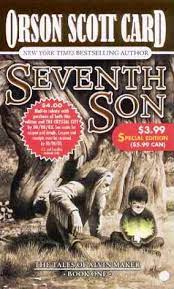Articles/Essays – Volume 21, No. 4
Joseph in an Alternate Universe | Orson Scott Card, Seventh Son
There is a time-honored tradition in science fiction and fantasy of the “alternate universe” story, set in a time and place partially familiar to the reader but with carefully chosen differences. Philip K. Dick’s The Man in the High Castle is set in a time much like our own except that the Axis powers were victorious in 1945; Katherine Kurtz’s Deryni books are set in a world rather like medieval Wales, except that magic telepathic powers play a significant role. An author may or may not devise a rationale for the existence of the alternate universe; the story-type has become so commonplace that readers seldom demand one. Certainly Mormons should have no trouble suspending disbelief in such cases: our cosmology embraces “worlds without number,” allowing for infinite variation.
Orson Scott Card’s new fantasy series, of which Seventh Son is the first volume, is based on just such an alternate universe. What we have here is the Joseph Smith story, in fair detail, in a universe in which magic — New World folk magic such as hex signs, dowsing, treasure-seeking, Native American magic, and the like — works. It promises to be — dare I say it? — a white salamander story. (The books haven’t got ten that far yet, though; it will be fun to see if the salamander makes it into the series or not.) Much has been changed, of course, including many of the names of the principal players; but there is hardly a well-known episode in the life of the young Joseph Smith that doesn’t somehow make its permuted way into the book.
In Card’s alternate vision, enlightenment and Protestant sentiments in England have resulted in numbers of visionaries and magic-sympathizers being deported to the colonies, where magic is openly fostered. This allows the aging William Blake to be on hand on this continent to tutor the young prophet and Thomas Jefferson and Benjamin Franklin to be admired for their skills in wizardry as much as for anything else. As in any other alternate-universe story, much of the delight of the narrative comes from working out the details of the permutations. Here Card does not disappoint us. Fantasy-reading friends of mine who have had no clue (until I informed them) of the doctrinal punch line that must inevitably come (in book three, I figure: book two, Red Prophet, is only out in hardback and so I have not read it, but I have heard that it is not the conclusion) have without exception enjoyed the story hugely thus far, chiefly because of these intriguing permutations.
I can’t help but wonder what will hap pen to these charmed readers when they get to the First Vision, though. But perhaps Card won’t get around to it. We’ve already had Moroni, or something like him. Some of my gentile friends were alarmed to hear that the other-worldly visitor who advises the Presbyterian minister (sometimes in the form of a dragon — or is it a salamander?) is intended to be The Devil, in capitals: what was he doing in a nice little nature-celebrating story that didn’t seem to be substantially occupied with Christian mythology? (You mean this is going to be a pro-Christian story? What a waste!) Increasingly the story is going to have to take sides, for better or worse, from here on out; in book one it has already begun to do so. For instance, if there are any Presbyterians left who are passionate enough to be offended, this book has of fended them; and those same fundamentalist Protestants who have been alienated by a certain section of the temple ceremony will, if they read the book, be alienated again by it. Surely Card knows how delicate his task is: to retell the Mormon sacred story in a way that honors the original but also entertains (without preaching at) the countless fantasy fans for whom our sacred story means nothing.
No book is perfect, of course. For instance, Card has again noted the “soft pink squishy” (his words!) nature of female flesh, an image that I have remarked on in previous reviews. Lithe muscular women do not abound in Card’s universes, but rather pendulous-buttocked and -breasted ballooning beauties. (The young prophet’s sisters are just such a bunch: they wobble flabbily as he chases them upstairs, intending to goose them.) In addition, the (intended) lively, earthy family talk that fills the books is not always, in my view, effective; the characters are sufficiently convinced of their own cuteness that I am reminded of the excesses of Heinlein’s later novels. Presumably, though, what can’t be cured must be endured.
Some years ago I expressed in print my disappointment that Card, an obviously talented writer in a largely transcendental genre, did not invest his writing with more explicitly Mormon themes. Now he has done it, and in spades: he has chosen the biggest Mormon story of them all. The Joseph Smith story is something that unfailingly calls up shivers and awe in the most jaded Latter-day Saint, regardless of our disillusionment with modern mega institutions and attitudes. The raw chutzpah of choosing that story takes one’s breath away. So far Card has not disappointed us, for the most part. I would venture to say that the Prophet himself would at least smile at this enterprise.
Seventh Son by Orson Scott Card (New York: Tom Doherty Associates, 1987), paperback, 241 pp., $3.95.


 Back to full Issue
Back to full Issue

